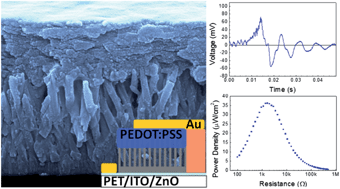Electromechanical energy harvesting converts mechanical energy from the environment, such as vibration or human activity, into electrical energy that can be used to power a low power electronic device. Nanostructured piezoelectric energy harvesting devices, often termed nanogenerators, have rapidly increased in measured output over recent years. With these improvements nanogenerators have the potential to compete with more traditional micro- or macroscopic energy harvesting devices based on piezoelectric ceramics such as lead zirconate titanate (PZT), polymers such as polyvinylidene fluoride (PVDF) or electrostatic, electret or electromagnetic kinetic energy harvesters. Power output from a nanogenerator is most commonly measured through open-circuit voltage and/or short-circuit current, where power may be estimated from the product of these values. Here we show that such measures do not provide a complete picture of the output of these devices, and can be misleading when attempting to compare alternative designs. In order to compare the power output from a nanogenerator, techniques must be improved in line with those used for more established technologies. We compare ZnO nanorod/poly(methyl methacrylate) (PMMA) and ZnO nanorod/poly(3,4-ethylenedioxythiophene) poly(styrenesulfonate) (PEDOT:PSS) devices, and show that despite an open-circuit voltage nearly three times lower the ZnO/PEDOT:PSS device generates 150 times more power on an optimum load. In addition, it is shown that the peak voltage and current output can be increased by straining the device more rapidly and therefore time-averaged power, or time-integrated measures of output such as total energy or total charge should be calculated. Finally, the internal impedance of the devices is characterised to develop an understanding of their behaviour and shows a much higher internal resistance but lower capacitive impedance for the ZnO/PMMA device. It is hoped that by following more rigorous testing procedures the performance of nanostructured piezoelectric devices can be compared more realistically to other energy harvesting technologies and improvements can be rapidly driven by a more complete understanding of their behaviour.

You have access to this article
 Please wait while we load your content...
Something went wrong. Try again?
Please wait while we load your content...
Something went wrong. Try again?


 Please wait while we load your content...
Please wait while we load your content...